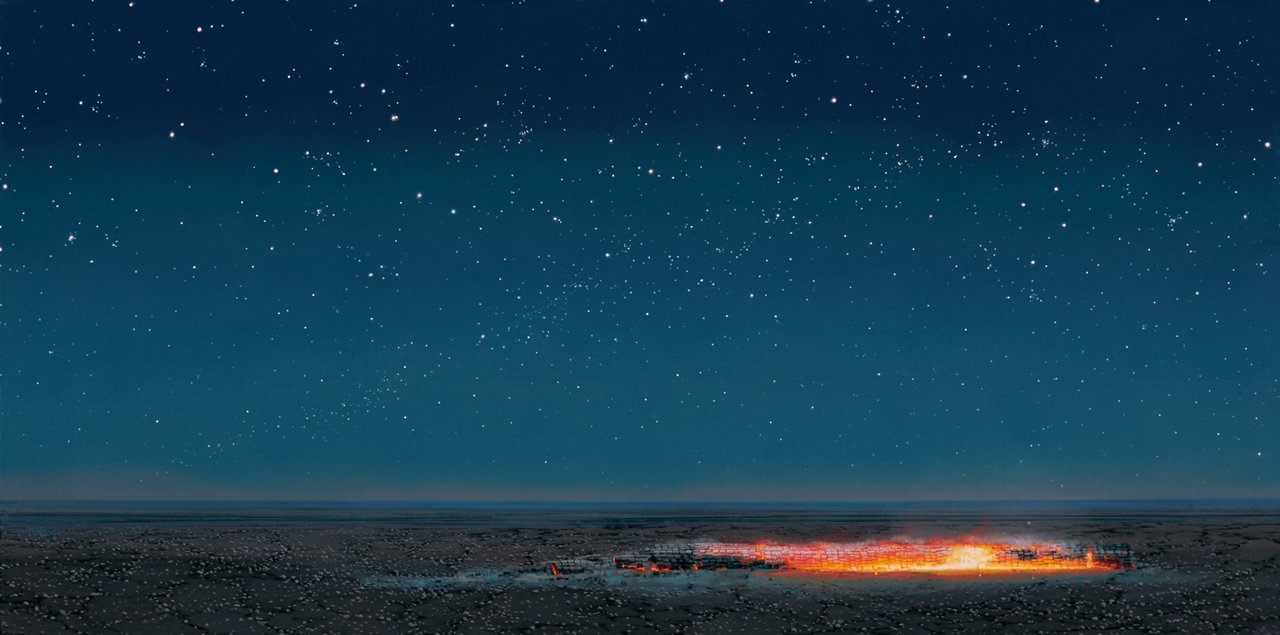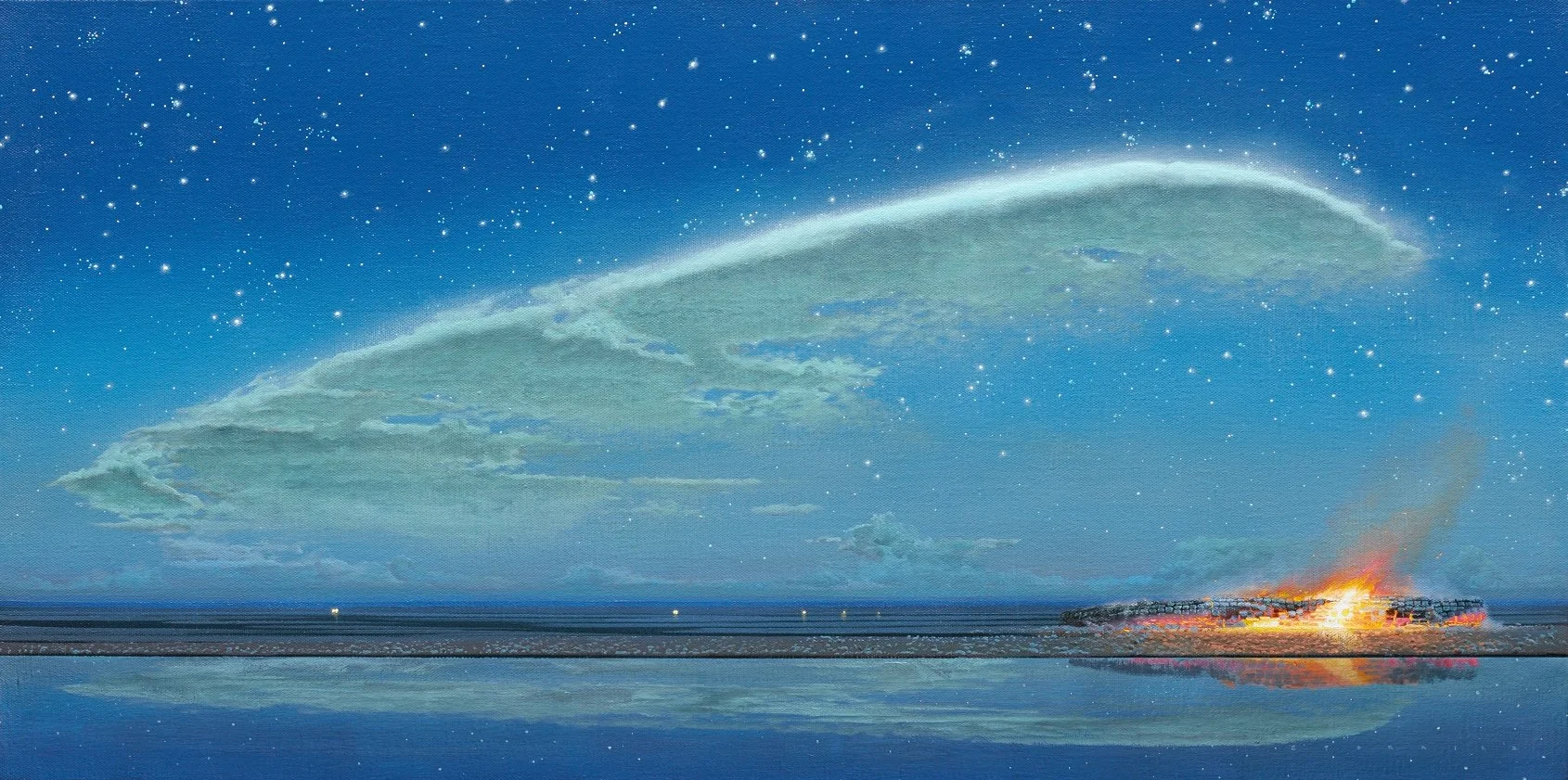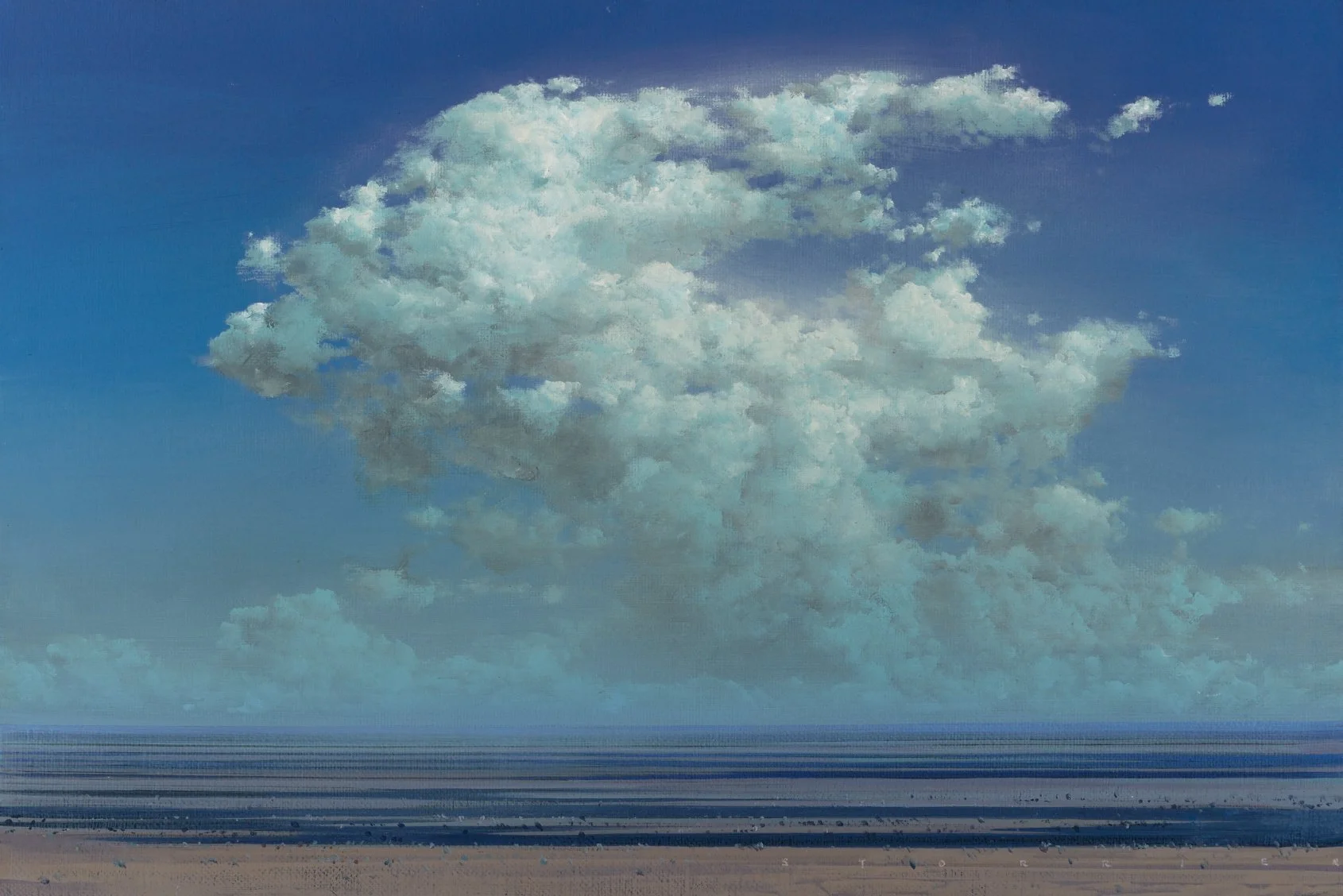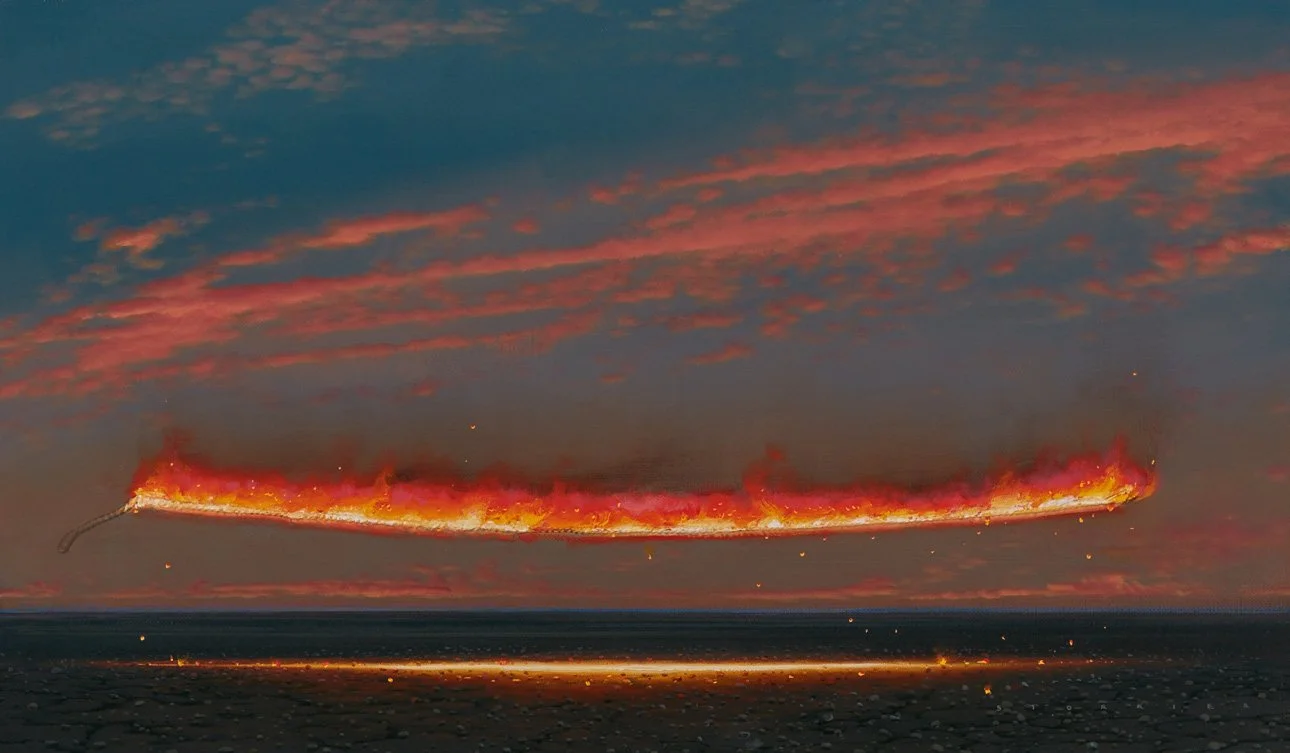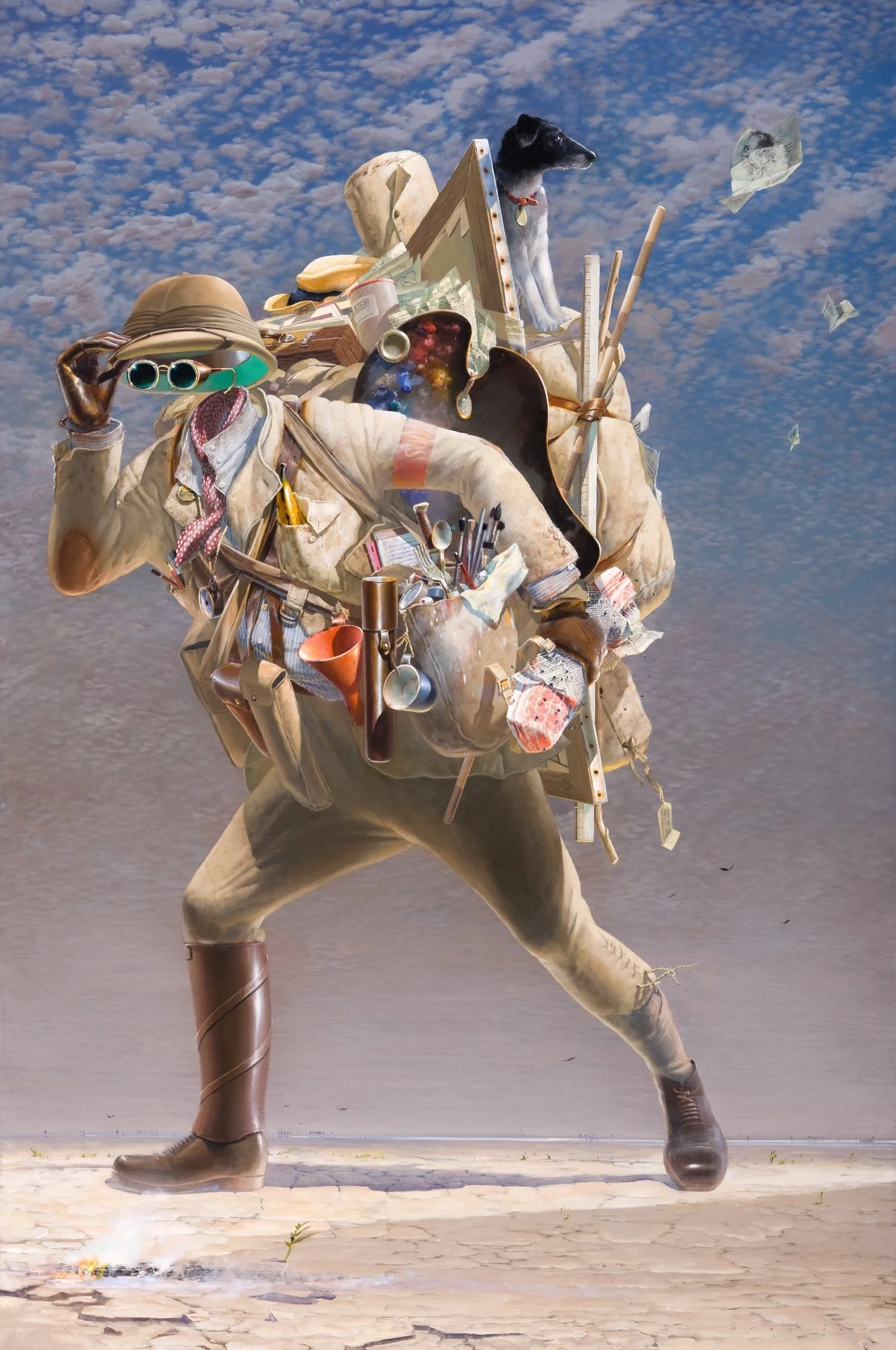Tim storrier paintings
Original paintings by Australian Fine Artist Tim Storrier Available for purchase.
TIM STORRIER PAINTINGS
Tim Storrier AM was born in Sydney in 1949. He is, arguably, Australia’s greatest living artist. He was awarded the Archibald Prize in 2012 for his allegorical self-portrait The Histrionic Wayfarer (after Bosch). Storrier’s work is defined by a distinctive imaginative vision and exceptional technical precision. Working across painting, sculpture, and works on paper, he continues to produce deeply considered and highly collectable pieces. Available paintings are listed below. For further details or enquiries about specific works, please refer to the FAQ section or contact Justin Combs at Artloft.
The Blue Ridge Blaze Line, Tim Storrier | Medium: Acylic paint on canvas | Dimensions: 82 x 246 cm
The Clear Night, Tim Storrier | Medium: Acylic paint on canvas | Dimensions: 76 x 152 cm
Reflected Night Cloud, Tim Storrier | Medium: Acylic paint on canvas | Dimensions: 61 x 122 cm
High (over the plain), Tim Storrier | Medium: Acylic paint on canvas | Dimensions: 41 x 61.5 cm
Stars (over the night road), Tim Storrier | Medium: Acylic paint on canvas | Dimensions: 110 x 244cm
Sundown Line (cherry), Tim Storrier | Medium: Acylic paint on canvas | Dimensions: 53 x 91 cm
The shadowed drift, Tim Storrier | Medium: Acylic paint on canvas | Dimensions: 61x122cm

paintings by Australian Artist Tim Storrier Available for purchase
Justin Combs of Artloft acts as an agent for Tim Storrier and can arrange private viewings of the artist’s paintings at his studio gallery in Bowral, NSW.
To express interest, arrange a viewing, or enquire about pricing, please use the contact form below. Alternatively, contact Justin Combs at Artloft Australia.
Justin Combs
justin@artloft.com.au
1300 831 124
enquiry form
Viewings by appointment only.
Frequently Asked Questions (FAQ) – Collectors & Institutions
-
Acquiring a Storrier artwork via Artloft is a personalized and transparent process designed to meet the needs of serious collectors and institutions. As Storrier’s agent, Justin Combs acts as the bridge between the artist’s studio and the buyer. Here is how the process typically works:
Enquiry and Consultation: Prospective buyers (whether private collectors, corporate collections, or public institutions) should start by contacting Artloft – either through the Enquiry form on our Tim Storrier page or directly via phone/email to our Artloft director, Justin Combs. In this initial conversation, we welcome you to share your interests – for example, are you drawn to Storrier’s blaze line landscapes, or a particular size or budget, or a certain period of his work? We have deep knowledge of Storrier’s entire body of work and can guide you through what might be available.
Viewing Available Works: Artloft maintains an up-to-date catalog of available Storrier works – including paintings, sculptures, and limited edition prints – either in our stockroom or accessible via the artist. We will present you with options that fit your collecting goals. This can include digital images, video footage, detailed descriptions, and provenance information for each piece. Often, clients express admiration for a specific Storrier piece they’ve seen in the past (perhaps in a gallery or publication); even if that exact work is sold or in a museum, telling us your taste helps us identify similar works or commission opportunities.
Private Viewings: For works under consideration, Artloft can arrange a private viewing. Uniquely, because Justin Combs works as Storrier’s gallerist, we usually host viewings at Storrier’s studio gallery in Bowral, NSW, by appointment. Seeing the artwork in person – its true scale, colors and texture – is invaluable. We can also accommodate viewings in other locations for client convenience, sometimes bringing smaller works to your location or arranging an exhibition space. Video links are also available on request and are the next best way to see a work if an in-person viewing is not possible.
Discussion of Pricing and Terms: Once you have selected a desired work, we will discuss the pricing and sale terms in more detail. If the work is a new piece, the price is usually determined by Storrier with Artloft brokering the sale as his agent. For commissions (yes, Storrier does accept commissions on a limited basis), Justin Combs will negotiate on the artist’s behalf, outlining the scope and quote for a custom painting. We are transparent about any applicable taxes or shipping costs (note: within Australia, door-to-door shipping is typically complimentary).
Acquisition and Documentation: Once terms are agreed, Storrier will provide a formal invoice or acquisition agreement. We coordinate payment (in AUD, via secure methods) and then move to the delivery phase. Every Storrier artwork sold comes with the aforementioned invoice directly from the artist’s studio. This functions as a top-tier authenticity and provenance document.
Delivery and Installation: Artloft and the Storrier studio arrange for professional packing and shipping of the artwork. For Australian buyers, we offer free insured delivery to your door. International buyers: we organize art-crating and liaise with shippers/customs, with costs discussed upfront. The work is handled with utmost care – Storrier’s frames and surfaces are protected during transit. Upon arrival, we can assist or advise on installation, given Storrier’s works can be large or require secure hanging (especially the multi-panel works or heavy bronzes).
After-Sales Support: Our relationship doesn’t end at the sale. Artloft remains available for any follow-up – be it advice on lighting the painting, hanging options and general collection advice. As the official agent, we can keep you informed of Storrier’s new releases, upcoming exhibitions, or market developments that might interest you as an owner of his work. We can also facilitate a meet-and-greet or studio visit with Tim Storrier if appropriate – many collectors find great value in connecting personally with the artist, enriching the story behind their acquired piece.
Throughout this process, Artloft’s role is to advocate for both the artist and you as the buyer, ensuring a smooth, confidential, and rewarding acquisition experience. We aim to make owning a Storrier not just a transaction, but a profound addition to your collection, backed by our expertise and Storrier’s enduring artistry.
-
Artloft strongly believes in the value of experiencing Storrier’s works in person, given their scale and detail, and we facilitate private viewings for qualified collectors and institutional curators. Since we act as Tim Storrier’s agent, we have unique access to his studio gallery and inventory, allowing us to arrange viewings that a typical gallery cannot.
Studio Gallery Visits (Bowral, NSW): Justin Combs of Artloft can arrange private viewings, by appointment, at Tim Storrier’s studio gallery on the estate in Bowral. This is a rare opportunity to see not only works that are for sale, but also perhaps works in progress, in the very environment where Storrier creates. Many collectors find that visiting the studio at Hopewood House – set in the picturesque Southern Highlands – adds depth to their appreciation. The studio gallery is a curated space showcasing a selection of Storrier’s recent paintings, sculptures, and works on paper. Privacy and confidentiality are assured; you will typically have the space to yourself or your small group to examine the art closely. We can accommodate special requests – for example, if there is a particular painting you’re interested in, we’ll seek to ensure it’s on display for your visit (assuming it’s available and not on loan elsewhere). Private tours of Hopewood House and Storrier’s personal collection can also take place by appointment.
In every case, the viewing experience is tailored to be comfortable and informative. Justin Combs will usually be present to answer questions about the work’s background, the story behind it, and its place in Storrier’s oeuvre – effectively a mini curated presentation. We can also provide comparison images of other works or catalogues during the visit if you want to discuss broader context. There is no obligation in scheduling a viewing. We encourage you to take that step – the Artloft team will facilitate a viewing at your convenience, thereby helping you make an informed and confident decision.
-
Provenance is a critical consideration for collectors, and Artloft ensures that the provenance of each Tim Storrier artwork is fully documented and trustworthy. As the approved agent working directly with Storrier, Artloft sources works either directly from the artist’s studio or from reputable collections. This means that when you acquire a Storrier painting or sculpture through Artloft, you receive clear documentation of its origin – typically including a signed statement or record from the artist’s studio confirming the work’s details, and any exhibition or ownership history if applicable. In many cases, especially for new works, the piece comes straight from Storrier’s studio inventory, giving buyers total confidence in its authenticity and history. For secondary-market works (resales), Artloft conducts due diligence: we vet the ownership chain, check exhibition or publication references, and, if needed, consult the artist or his archivists to confirm the piece’s background.
-
The pricing of a Tim Storrier painting takes into account a range of factors reflecting both the art market and the artwork’s inherent qualities. As with most esteemed artists, there is no simple price per square inch; instead, experts (and Storrier’s representatives like Justin Combs) weigh several key considerations:
Size and Medium: Larger canvases generally command higher prices than smaller works, but size alone is not determinative. Storrier’s epic large-scale oils and acrylics (spanning several meters) are especially prized for their impact. However, even his smaller paintings or drawings can be very valuable if they are jewel-like in detail or rarity.
Subject Matter and Series: Certain themes in Storrier’s oeuvre are iconic and thus more sought-after. For example, a “Blaze Line” fire landscape from the 1990s – being a signature subject – may fetch a premium. A unique or pivotal piece (e.g. a painting that won an award or was in a notable exhibition) may drive up desirability.
Date and Period: Storrier’s career spans different periods – early works from the 1960s–70s can be scarce and historically significant, while the 1980s-90s saw the development of his classic style (fire horizons, etc.), and the 2000s-2010s introduced new allegorical elements. Each period has its market following. Generally, paintings from the height of Storrier’s mature period (1980s–2020s) to the present day are the most sought after, but exceptionally innovative, well-preserved early works can be popular (such as the saddle series).
Condition and Framing: The state of the artwork is fundamental. Storrier’s paintings are well executed with high-quality materials and are well-constructed. Storrier typically uses luxurious hand-gilded frames, which are included in the price and enhance the presentation (and value) of the piece. A custom water-gilded frame chosen by the artist adds a touch of uniqueness that collectors appreciate.
Storrier’s prices are determined case-by-case, considering all the above. We discuss openly with collectors the rationale behind a piece’s price – whether it’s the rarity, the size, or its importance in Storrier’s career – so you can make an informed decision. Because we handle Storrier’s sales on his behalf, prices for primary-market works (new or directly from the artist) are set in consultation with Storrier.
-
Tim Storrier has a rich and varied body of work, and different collectors may favor different periods. Broadly speaking, a few key periods and series stand out as especially significant and sought-after:
Late 1960s – Early 1970s (Emergence): Storrier’s student and immediate post-student years, when he first gained fame. Works from this early phase are fairly rare on the market. They are historically important as they show Storrier’s youthful energy and hint at themes he would later explore.
Late 1970s – 1980s (The Outback Iconography and Blaze Line): This is the period where Storrier began to forge his signature style. Having moved away from overt figuration, he concentrated on landscape as theater – big skies, flat horizons – and introduced the symbolic campfire elements. The late ’70s saw his detailed saddle and outback gear paintings, which are beautiful meditations on rural life’s tools. Then, the 1980s brought the famous fire imagery. Paintings like Point to Point (Evening blaze line) (c.1988-90) or The Burn (Sulman Prize 1984) come from this era. Collectors highly value these for their iconic status – they encapsulate Storrier’s contribution to Australian art.
1990s to early 2000s (Refinement and International Reach): In the 1990s, Storrier continued to refine his techniques and expand his content. He traveled extensively (Egypt, Europe, Antarctica), which subtly informed some works (e.g. incorporating new landscapes or atmospheric effects). During this decade, he produced “Night Landscapes” with incredibly detailed star fields, and also some whimsical additions like floating debris or celestial phenomena. While perhaps less thematically unified than the 1980s, the ’90s output showed Storrier’s range. A standout from this time is his “paper darts” motif which began in the 2000s, where large paper airplanes glide through epic skies.
Collectors interested in Storrier’s imaginative side find these pieces significant – they’re surreal, playful, and yet still contemplative.
2005 – Present (Allegorical and Late Career Highlights): In the new millennium, Storrier reintroduced figurative elements in a deeply personal, allegorical way. Notably, his In Absentia series and related works feature figures (or proxies for figures, like empty clothing) in desert settings – a dramatic departure after decades of no people on canvas. This culminated in 2012 with The Histrionic Wayfarer (after Bosch), which not only won the Archibald Prize but also symbolized Storrier’s full circle journey back to figurative painting, albeit imbued with all the symbolism and metaphysics he had gathered. Collectors and curators view these recent works as significant because they add a new chapter to Storrier’s legacy. For instance, owning the painting Moon Boy (Self-portrait as a young man) or The Wayfarer (if it were to be available) would be acquiring a piece of art prize history and the artist’s self-reflection. Additionally, the bronze sculptures of the 2010s – The Wayfarer (2014) and Grand Impedimenta (2016–17) – are significant three-dimensional extensions of his themes; institutions in particular might consider these to show Storrier’s influence beyond painting.
In essence, every phase of Storrier’s career has its highlights. If you are a curator building a comprehensive overview, you would ideally include an early piece, a blaze line landscape, and a late-career allegory to show the evolution. Private collectors often start with what resonates most – many fall in love with the fire line imagery at first (for its visual drama), whereas others might connect with the poetic solitude of his later allegories. Artloft can provide guidance on the significance of any specific work you are considering: we’ll inform you if, say, a painting was part of a renowned series, or if it represents a transitional moment in Storrier’s practice. We also keep an eye out for milestone works that become available privately. Remember that some of Storrier’s major works are held by public museums (and unlikely to be sold), but excellent examples from each period do reappear from time to time.
Tim Storrier AM (b. 1949) –
Tim Storrier AM is a leading figure in Australian art, indeed he is, arguably, Australia’s greatest living artist, acclaimed for his richly symbolic depictions of fire, sky, and desert. Over a career spanning more than fifty years, Storrier has maintained a distinctive and technically virtuosic practice that bridges landscape, allegory, and the metaphysical. He first came to national attention in 1968 when, at just 19, he won the Sir John Sulman Prize—becoming the youngest artist to ever do so. His subsequent accolades include the Sulman Prize (again in 1984), the Archibald Prize (2012), the Doug Moran National Portrait Prize (2017), and appointment as a Member of the Order of Australia in 1994 for services to the visual arts.
Born in Sydney and raised on a sheep station in rural New South Wales, Storrier developed a lifelong relationship with the outback landscape—an environment that would become both setting and subject of his work. Early mentorships with Brett Whiteley and John Olsen helped refine his visual language, while a formative trip to Lake Eyre in 1976 sparked the spiritual and psychological tone that defines much of his work. Rather than populate his landscapes with figures, Storrier introduced symbolic objects—saddles, fire ropes, weathered gear—imbued with memory and metaphor. John Olsen once remarked, Storrier is “one of the most secretive and enigmatic artists working in Australia today… unpredictable in intention, and one of the most original.” These recurring motifs speak to solitude, endurance, and the traces of human presence in a vast, silent landscape.
Among Storrier’s most celebrated works is the “Blaze Line” series—paintings of ropes set alight across the horizon, glowing against evening skies. Originally conceived as a real-world experiment in the 1980s, these images have become modern icons in Australian art, representing both the impermanence of human passage and the elemental forces of fire, air, and time. Storrier’s landscapes, often devoid of figures yet rich with atmosphere, are executed with an extraordinary degree of realism. His skies shimmer with distant stars, his terrain glows with embers, and each canvas invites both contemplation and awe.
In recent decades, Storrier reintroduced the figure in a series of allegorical self-portraits and sculptures. Most notably, The Histrionic Wayfarer (after Bosch), which won the 2012 Archibald Prize, features the artist as a faceless traveller—laden with brushes, books, and maps—crossing a sunlit plain. These later works reflect a shift in focus from the outer to the inner landscape, exploring themes of burden, memory, and the solitary journey of the artist. Sculptural works such as The Wayfarer and Grand Impedimenta further extend this narrative, translating Storrier’s symbolic visual language into three dimensions.
Storrier’s work is held in the National Gallery of Australia, all major state institutions, and internationally in the Metropolitan Museum of Art (New York). He has exhibited widely in Australia and overseas, and his paintings are held in significant private and corporate collections. Today, Storrier is regarded as one of Australia’s most accomplished and original artists—an innovator who has remained faithful to the poetics of painting while continually evolving his personal mythology. Justin Combs of Artloft is proud to represent Storrier as an approved agent, offering access to his latest works for collectors and institutions.


